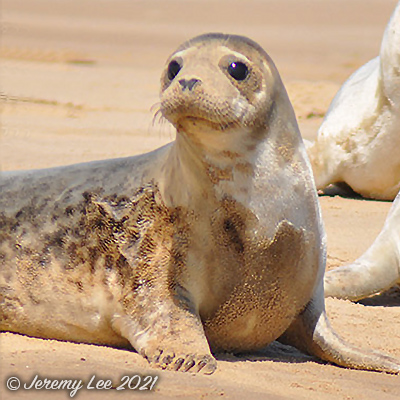
 |
|
Scientific Classifications explained » Amphibians » Ants » Aphids » Bees » Beetles » Birds » Bugs » Butterflies » Caterpillars » Damselflies » Dragonflies » Earwigs » Flies » Frog/Leafhoppers » Fungi » Galls » Grasshoppers » Harvestmen » Hoverflies » Lacewings » Ladybirds » Leaf Mines » Lichens » Mammals » Millipedes » Mosses » Moths » Sawflies » Slugs » Snails » Spiders » Trees & Shrubs » Wasps » Wild Flowers » Woodlice » Postboxes |
UK Nature > Mammals > Phoca vitulina

Scientific Name: Phoca vitulina Common Name: Common Seal The smaller of our two seal species, Phoca vitulina, the Common Seal (also known as Harbour Seals) are more commonly found around sheltered shores and estuaries, where they haul out on sandbanks and beaches. A tell-tale sign of the Common Seal is when out of the water, they sometimes hold their body in a curved 'banana' position, with their head and tail both in the air at the same time. Like Grey Seals, they feed on fish, but also eat squid, whelks, crabs and mussels. The young are born during the summer. Can be distinguished from the Grey Seal by its smaller size and shorter head with a blunter, more dog-like profile. Very variable in colour, from blonde to black, but generally grey with dark spots. Found around the coasts of Scotland, Northern Ireland and eastern England. |
|

https://www.uknature.co.uk is a website dedicated to showing the immense diversity of UK nature and wildlife. Our vast range of habitats, from lowland arable to snow covered mountains, from storm-ravaged coastlines to peaceful inland freshwater lakes and rivers, from dry, sandy heaths to deciduous and coniferous forests, all these habitats contribute to the abundance of UK nature. We have wild birds in huge numbers either residing or visiting our shores (597 recorded species as at July 2013) and we must also not forget the humble back garden with its grass lawns, flower beds filled with nectar rich flowers, shrubs and trees, all designed to attract huge numbers of insects such as bees, moths, butterflies and hoverflies; and finally the small ponds which provide safe havens for frogs, toads, newts and even slow worms and grass snakes. www.uknature.co.uk is the showcase for my personal passion, photographing uknature in all its glory. I sincerely hope you all enjoy the fruits of my labours. This site and all images contained therein is © Jeremy Lee 2004 - 2025. All Rights Reserved. Site design by Jeremy Lee. Site development & IT Support by Stuart Lee. |